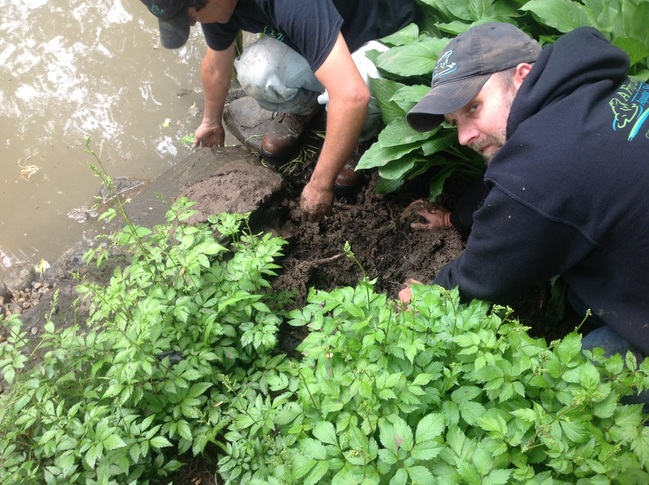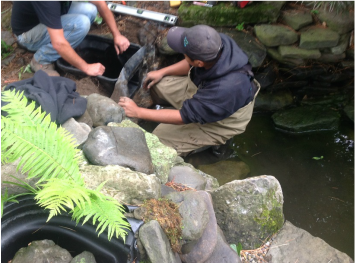Pond Leak Detection and Pond Repair
Morris, Hunterdon, and Somerset New Jersey
 Pipe Repair
Pipe Repair
There is only one reason why a pond owner in New Jersey landed on this page, You think you may have a pond leak in your water feature. Before giving us a call, you may want to read on, let’s see if we can determine if you really have a leak.
Leaks are among the most misunderstood and misdiagnosed problems anyone can have in their pond. Understanding the basic principles of pond leak detection and repair will save you time, money, and headaches in your water gardening adventures … I guarantee it!
What is Evaporation?
First, let’s have a look at what evaporation is and what it isn’t. Evaporation is caused by water turning into a vapor and escaping from your pond. The amount of water loss will vary according to the region of the country and the time of year. Ponds that are located in areas of the country with moderate temperatures and high humidity can expect to see 1 to 1 ½ inches of water loss per week during the spring and summer. Most of this evaporation should be replaced naturally by rain. However, if you live in an area with high temperatures and low humidity, it’s possible to see 3 inches or more of evaporation in a week. For those of us in the New Jersey area, we can expect to see water loss from evaporation between the 1 1/2 to 3 inches per week mark. However, before using this as a bench mark, make sure you read on, because the construction of your waterfall will have a huge impact on your water loss due to evaporation.
The quantity and size of your waterfall(s) will also affect the amount of water that is lost. Regardless of the climate, a 4’x 6’pond with a 20-foot stream and 5 feet of cascading waterfalls may lose as much as 2 inches or more every day! Why? Splashing and moving water has greater exposure to additional evaporation than does the still water in the pond. If that same pond was 16′ x 21′ pond, you’d probably never even notice the additional evaporation because it’s a larger pond.
What It Isn’t
Evaporation is not filling your pond up all the way one evening, and waking up the next morning to find the water six inches lower. That’s a leak! If your pond is experiencing a loss of water at a more rapid rate, you either have a leak, or your frogs are drinking the water. Seriously, let’s figure that it’s a leak. What do you do then?
Leaks are among the most misunderstood and misdiagnosed problems anyone can have in their pond. Understanding the basic principles of pond leak detection and repair will save you time, money, and headaches in your water gardening adventures … I guarantee it!
What is Evaporation?
First, let’s have a look at what evaporation is and what it isn’t. Evaporation is caused by water turning into a vapor and escaping from your pond. The amount of water loss will vary according to the region of the country and the time of year. Ponds that are located in areas of the country with moderate temperatures and high humidity can expect to see 1 to 1 ½ inches of water loss per week during the spring and summer. Most of this evaporation should be replaced naturally by rain. However, if you live in an area with high temperatures and low humidity, it’s possible to see 3 inches or more of evaporation in a week. For those of us in the New Jersey area, we can expect to see water loss from evaporation between the 1 1/2 to 3 inches per week mark. However, before using this as a bench mark, make sure you read on, because the construction of your waterfall will have a huge impact on your water loss due to evaporation.
The quantity and size of your waterfall(s) will also affect the amount of water that is lost. Regardless of the climate, a 4’x 6’pond with a 20-foot stream and 5 feet of cascading waterfalls may lose as much as 2 inches or more every day! Why? Splashing and moving water has greater exposure to additional evaporation than does the still water in the pond. If that same pond was 16′ x 21′ pond, you’d probably never even notice the additional evaporation because it’s a larger pond.
What It Isn’t
Evaporation is not filling your pond up all the way one evening, and waking up the next morning to find the water six inches lower. That’s a leak! If your pond is experiencing a loss of water at a more rapid rate, you either have a leak, or your frogs are drinking the water. Seriously, let’s figure that it’s a leak. What do you do then?

Low Edges
Look for any low edges. Settling at the pond’s edge is the most common cause of a leak, especially in a new pond. Typically, the low edges are found around the stream and waterfall where settling may have occurred after a few rainfalls. These areas are usually built up during the construction of the pond using the soil from the excavation, and are prone to some settling.
Your first line of defense is to carefully inspect the edges of not only your stream and waterfall, but also the perimeter of the pond. As the dirt around the stream or waterfall settles, it can create low spots that may cause water to escape over the edge of the liner. Keep your eyes peeled for wet mulch or gravel, or muddy areas around the perimeter of your pond. If you find a spot that’s leaking, all you have to do is lift the liner up and push some soil under it in order to raise the edge. Bingo – leak fixed!
Another possibility is that water is splashing out of your stream. To fix a “splash leak,” all you have to do is adjust a few of the rocks under and around your waterfall. This will contain or redirect the splash and it will stop the splash leak. Once again, you’ve solved the problem the easy and cost-effective way … using common sense.
Low edges can be built back up by simply backfilling and compacting soil beneath the liner in order to raise the edge of the liner above the water level.
Obstructions in the Stream and Waterfalls
In addition to checking for low edges, you should also check your stream and waterfall. Rocks and excessive plant or algae growth in the stream or BIOFALLS® filter can restrict the flow of water and divert it over the edge of the liner. Plants and algae should be maintained by trimming them back in order to let the water pass freely. All in all, these leaks are extremely easy to fix.
Still Leaking?
You’ve spent 15 minutes or so following the suggestions listed above and you still can’t find the leak. What do you do next? It’s time for a little more work, and some drastic measures. You’ll have to shut your pump off for a day. By doing this, you’ll be able to determine the approximate location of the leak.
Steady and Level
If the water level remains the same, then it is safe to assume that that the leak is not in the pond. Now you’ll need to check the pipe, the plumbing fittings, and the pump connections for leaks.
Another possible culprit is the faceplate of your skimmer, if you have one. If the water level stopped dropping above the bottom of the faceplate you should investigate the skimmer. It may not have sealed correctly.
Look for any low edges. Settling at the pond’s edge is the most common cause of a leak, especially in a new pond. Typically, the low edges are found around the stream and waterfall where settling may have occurred after a few rainfalls. These areas are usually built up during the construction of the pond using the soil from the excavation, and are prone to some settling.
Your first line of defense is to carefully inspect the edges of not only your stream and waterfall, but also the perimeter of the pond. As the dirt around the stream or waterfall settles, it can create low spots that may cause water to escape over the edge of the liner. Keep your eyes peeled for wet mulch or gravel, or muddy areas around the perimeter of your pond. If you find a spot that’s leaking, all you have to do is lift the liner up and push some soil under it in order to raise the edge. Bingo – leak fixed!
Another possibility is that water is splashing out of your stream. To fix a “splash leak,” all you have to do is adjust a few of the rocks under and around your waterfall. This will contain or redirect the splash and it will stop the splash leak. Once again, you’ve solved the problem the easy and cost-effective way … using common sense.
Low edges can be built back up by simply backfilling and compacting soil beneath the liner in order to raise the edge of the liner above the water level.
Obstructions in the Stream and Waterfalls
In addition to checking for low edges, you should also check your stream and waterfall. Rocks and excessive plant or algae growth in the stream or BIOFALLS® filter can restrict the flow of water and divert it over the edge of the liner. Plants and algae should be maintained by trimming them back in order to let the water pass freely. All in all, these leaks are extremely easy to fix.
Still Leaking?
You’ve spent 15 minutes or so following the suggestions listed above and you still can’t find the leak. What do you do next? It’s time for a little more work, and some drastic measures. You’ll have to shut your pump off for a day. By doing this, you’ll be able to determine the approximate location of the leak.
- Make sure the pond is filled to the appropriate level.
- Unplug the pump.
- Let the pond sit for 24 hours.
- If the water level drops, then you know the leak is in the pond.
- To find out where the leak is occurring, allow the water level to continue to drop. The level where the water stops dropping is the level where the leak is located.
- Concentrate your search around the perimeter of the pond at the level that the water has stopped dropping.
- Remove any rocks around the entire perimeter at the level where the water stopped. You can then carefully check for some sort of puncture, or hole in the liner.
- When you find the hole, you simply patch it with a liner patch kit available at pond supply retailers.
- Now you can replace the rocks, fill the pond back to the top, and enjoy!
Steady and Level
If the water level remains the same, then it is safe to assume that that the leak is not in the pond. Now you’ll need to check the pipe, the plumbing fittings, and the pump connections for leaks.
Another possible culprit is the faceplate of your skimmer, if you have one. If the water level stopped dropping above the bottom of the faceplate you should investigate the skimmer. It may not have sealed correctly.
 Pond Skimmer Repair
Pond Skimmer Repair
If the Leak Is in the Skimmer
Simply move a few rocks around the front of the skimmer and slide your hand behind the liner, feeling for wet soil around the opening of the skimmer. If the soil is saturated, then the faceplate may have not been installed properly and might be the source of the leak. If this is the case you should certainly give us a call.
It’s not fun when your pond is losing water. It can be a time-consuming and frustrating process to locate the leak. Hopefully with these steps and tips, you can quickly locate the source of the leak and get right back to enjoying your water garden.
Simply move a few rocks around the front of the skimmer and slide your hand behind the liner, feeling for wet soil around the opening of the skimmer. If the soil is saturated, then the faceplate may have not been installed properly and might be the source of the leak. If this is the case you should certainly give us a call.
It’s not fun when your pond is losing water. It can be a time-consuming and frustrating process to locate the leak. Hopefully with these steps and tips, you can quickly locate the source of the leak and get right back to enjoying your water garden.
A Frog's Dream Aquatic Services is a Morris County, New Jersey area based full service Pond contractor & Pond Maintenance landscape company specializing in naturalistic water features, and unique outdoor spaces, including Ponds, Water Gardens and Stream Design, Construction, Repair, Renovation &Maintenance Serving Morris County, Hunterdon County, and Somerset County in New Jersey. A Frog's Dream was founded to fill a need for a full service water feature company that truly cares about the details of every project and service.
Our pond repair service areas include most of Northern New Jersey
Contact us if you don’t see your County or town listed below
Morris, Hunterdon and Somerset Counties
——–
Long Valley, Chester, Far Hills, Bernardsville, Mendham, Peapack, Gladstone, Whitehouse, Whitehouse Station, Basking Ridge, Madison, Green Village, Morristown, Randolph, Roxbuy, Califon, Bridgewater, Somerville, Pittstown, Long Valley, Tewksbury, Chatham, Morris Township, Pittstown, Flemington, Clinton, Asbury, Flanders, Succasunna, Montville, Denville, Morris Plains, Short Hills, Bedminster, Bound Brook,
Glen Gardner, Florham Park, High Bridge, Hillsborough, Hopatcong, Ledgewood, Liberty Corner, Martinsville, Mountainside, Harding, Neshanic Station, New Vernon, Oldwick, Raritan, Sparta, Summit, Warren, Cedar Knolls
Contact us if you don’t see your County or town listed below
Morris, Hunterdon and Somerset Counties
——–
Long Valley, Chester, Far Hills, Bernardsville, Mendham, Peapack, Gladstone, Whitehouse, Whitehouse Station, Basking Ridge, Madison, Green Village, Morristown, Randolph, Roxbuy, Califon, Bridgewater, Somerville, Pittstown, Long Valley, Tewksbury, Chatham, Morris Township, Pittstown, Flemington, Clinton, Asbury, Flanders, Succasunna, Montville, Denville, Morris Plains, Short Hills, Bedminster, Bound Brook,
Glen Gardner, Florham Park, High Bridge, Hillsborough, Hopatcong, Ledgewood, Liberty Corner, Martinsville, Mountainside, Harding, Neshanic Station, New Vernon, Oldwick, Raritan, Sparta, Summit, Warren, Cedar Knolls
Location |
|









